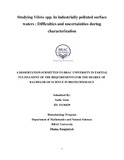Studying vibrio spp. in industrially polluted surface waters : difficulties and uncertainities during characterization
Abstract
4
Abstract
.
Being the capital of Bangladesh Dhaka city faces multiple pollution problems due to rapid urbanization leading to unplanned industrialization. This often results in the contamination of water bodies with bacteria pathogenic to humans. This eventually increases the risk of humans getting infected during accidental ingestion or contact. The purpose of the study was to detect the presence of Vibrio spp. in water bodies contaminated with industrial pollutants. For this purpose Gulshan Lake and Buriganga River, the two prominent water bodies of our country were chosen for sampling. A total of 80 samples were collected aseptically. In total, 70 samples were from Gulshan Lake and 20 samples were from Buriganga River within duration of three months. Then, they were processed for isolation of culturable Vibrio spp. using culture-based method. Of these water samples, 67% were found positive for Vibrio spp. and the rest were found to be non-Vibrio.Biochemical tests were then performed to confirm DNA extraction in boiling method was performed before the Genus specific PCR targeting the rpoA gene for further confirmation. Then helomysis test was performed where 86% isolates gave beta hemolysis and 14% isolates gave gamma hemolysis. Anbibiotic susceptibility and resistant test was done against ten antibiotics where Nalidixic acid (30μg) showed highest(86%) resistance and Tetracycline (30μg) showed lowest (14%) resistance. This study reveals that both Gulshan Lake and Buriganga river are contaminated with Vibrio spp. and can be highly virulent that may lead to serious health hazard in near future.

